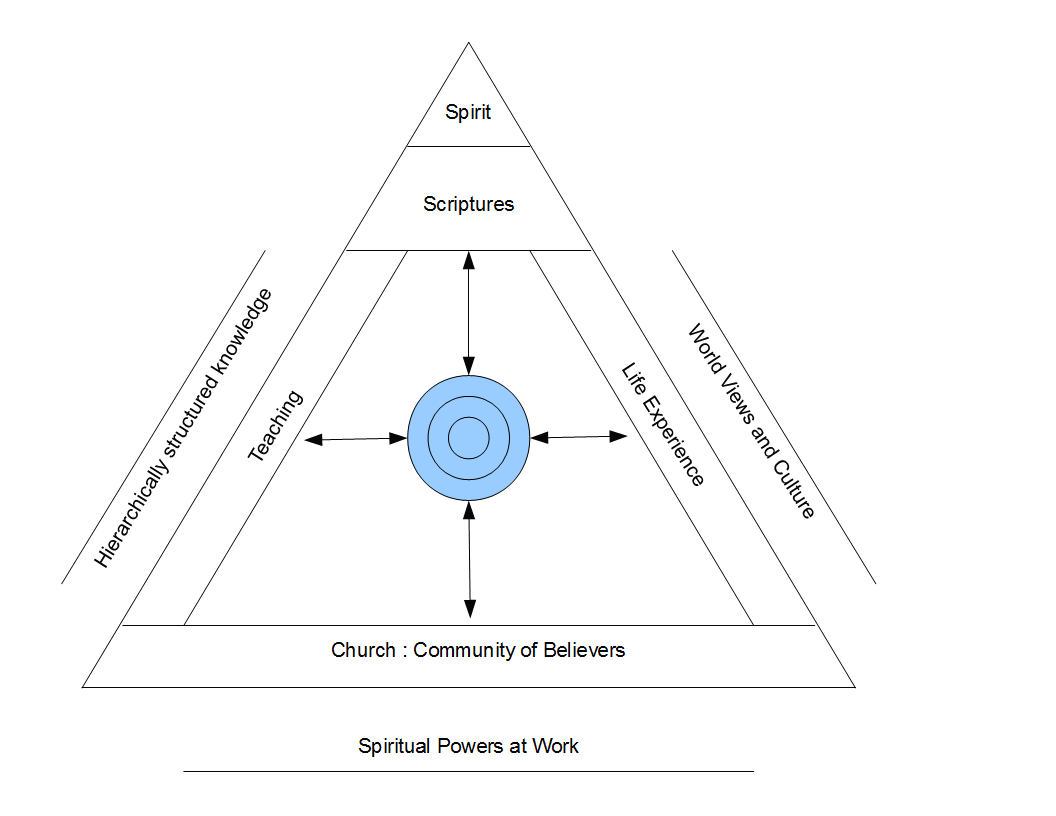Knowing and Believing
May 25, 2014
The diagram below is drawn from ch. 5, Intégration Bible et spiritualité chrétienne, of my essay, Comment donc comprendre la Bible aujourd'hui ? (pdf, 139 p.). It illustrates the factors that are taken into account in the choices a person makes with regards to believing and knowing. "Scripture", in this context, means, of course, the Bible.

The blue circle at the centre represents the human person in the complexity of his conscious, semi-conscious and unconscious dimensions. It includes that which a person keeps secret or hides, presenting herself at times in all authenticity, at times knowingly or unknowingly wearing a mask. Bidirectional arrows suggest that we also bear our imprint in each of the spheres illustrated.
Outside that blue circle, the hierarchically structured knowledge represents, for example, those sciences that are said pure or hard and those sometimes called soft, such as what can be learnt from the humanities, and the lower degree of certainty that it is thought possible to draw from the latter as opposed to the former.
World views and culture refer to ways of being and doing adopted by collectivities and based upon modes of thinking and of talking learnt from the environment we live in, where the way we express what we think by talking about it, is also the means through which are taught or shared and reinforced our modes of thinking.
These latter two spheres of hierarchically structured knowledge and world views and culture in and of themselves contribute in determining if we will be able to admit or no the presence of a third sphere of influence, that of spiritual powers at work.
As far as the triangle itself goes, it represents those elements that leave their mark on us and on which we leave ours. We reinforce, them whenever we are abounding in the direction we are invited to by the hierarchically structured knowledge that happen to be the most valued within a given time frame and within a given context. On the other hand, when we have the courage to differ from some of the commonly accepted ways of defining things because we consider some aspects of reality to be left aside, we then assume a much needed function of cultural counterweight.
For example, if we allow ourselves to be moved by Him who speaks from the Heavens above through the Scriptures and, through His Spirit, invites us to Him, the effect of such a choice on our part will be manifested in all of the spheres mentioned above. If on the other hand we allow, either our own experience, or our church group and its teachings, to block our access to God, to His Spirit, and to His Word, we then will be alone in this world, being deprived of the true sources of life and of knowledge.
You might also want to check out 100 Hyntley Street
(Videos -> Interviews -> Search Videos) :
-
The Bible - Made in God's Image, Dr. Craig Evans, Mar 5, 2013;
-
God's Story of Love and Transformation, Dr. Craig Evans, Mar 8, 2013;
-
Making Sense Of Our World Through Christian Perspective (1/2),
L.T. Jeyachandran, October, 2010; -
Making Sense Of Our World Through Christian Perspective (2/2),
L.T. Jeyachandran, October, 2010; -
Religion & War, Dr. Ravi Zacharias, March 27, 2010;
-
Can There Be Meaning Without God?, Dr. William Lane Craig, April 23, 2009;
-
How Can Christianity Be The One True Religion?,
Dr. William Lane Craig, May 12, 2009; -
Historical Resurrection of Christ?, N.T. Wright, January 5, 2009.